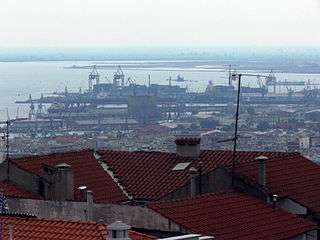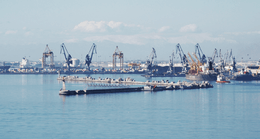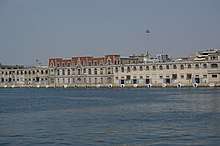Port of Thessaloniki
The Port of Thessaloniki (Greek: Λιμάνι της Θεσσαλονίκης) is one of the largest Greek seaports and one of the largest ports in the Aegean Sea basin, with a total annual traffic capacity of 16 million tonnes (7 million tonnes dry bulk and 9 million tonnes liquid bulk). The Port of Thessaloniki contains the second largest container port in Greece, after the Port of Piraeus. It is the largest port in the Greek region of Macedonia. As a free port, it also functions as a major gateway for the Balkan hinterland and southeastern Europe.
| Port of Thessaloniki | |
|---|---|
 Overview | |
| Location | |
| Country | |
| Location | |
| UN/LOCODE | GRSKG[1] |
| Details | |
| Operated by | Thessaloniki Port Authority (Athex: OLTH) |
| Owned by | South Europe Gateway Thessaloniki Ltd (67%)[2] Deutsche Invest Equity Partners GmbH – 47% Terminal Link SAS – 33% Belterra Investments Ltd – 20% HRADF (7.27%)[3] Other Shareholders (25.73%)[4] |
| Type of harbor | Natural/Artificial |
| Size | 155 ha (1.55 sq km) |
| Employees | 2,200[5] (2014) |
| General manager | Sotirios Theofanis |
| Statistics | |
| Vessel arrivals | ▲ 3,064 vessels (2014)[6] |
| Annual cargo tonnage | ▲ 18,127,224 tonnes (2010)[6] |
| Annual container volume | ▲ 293,282 TEU's (2014)[6] |
| Passenger traffic | ▼ 180,755 people (2010)[6] |
| Annual revenue | |
| Net income | |
| Website www.thpa.gr | |


Statistics
In 2007 the Port of Thessaloniki handled 14,373,245 tonnes of cargo and 222,824 TEU's, making it one of the busiest cargo ports in Greece and the second largest container port in the country.
| Years | 2007 | 2008 |
|---|---|---|
| Cement | 871,936 | 810,311 |
| Liquid bulk | 7,618,622 | 7,347,922 |
| Dry bulk | 7,740,920 | 6,215,012 |
| Containers (TEU's) | 408,212 | 222,824 |
| Total | 16,231,478 | 14,373,245 |
Terminals
Container terminal
The port's container terminal has a storage area of 350,000 m2 and a storage capacity of 4,696 TEU's in ground slots.[10]
The container terminal is currently being expanded by 36 hectares, following an investment of around US$600 million by the Hong Kong-based company, Hutchison Port Holdings.[11] The Hong Kong-based company won the tender after surpassing a first offer made by COSCO Pacific, which offered around US$500 million for the development of the container terminal. In 2009 Hutchinson didn't find the money to pay for the concession of the port and so they lost it.
Cargo terminal
The cargo terminal has a total storage area of 1,000,000 m2 and specializes in the handling of wide cargo that ranges from metal products, ore, chemical products (chloroform, asphalt, chemicals, mineral oils), general cargoes, timber, bulk cargoes and food products.[12] The terminal also serves as a major transshipment hub in the Aegean — Black Sea area being used by other Balkan countries such as Serbia, North Macedonia, Albania and Montenegro.
Oil and gas terminal
The oil and gas terminal has a total storage capacity of 500,000 m3[13] and an annual traffic capacity of 9,000,000 tonnes per year.
Passenger terminal

The Port of Thessaloniki has one of the largest passenger terminals in the Aegean Sea basin. The passenger terminal handled around 162,731 passengers in 2007,[14] but since then it has fallen into disuse as passenger lines were cancelled during the years of the Greek debt crisis. The building of the passenger terminal, previously the customs house, was constructed in the last three years of the Ottoman period (1909-1912) by the local Jewish architect Eli Modiano, based on designs by the Franco-Levantine architect Alexander Vallaury.
Other

In the area above the port, traditionally called "Vardaris" (and "Varonou Hirs", Baron Hirsch, a quarter of the area), the Holocaust Museum of Greece, among others, is being constructed. The old railway station, from where the Jews of the city were deported to Auschwitz concentration camp, was located in this area and the museum is being constructed on land leased by the Hellenic Railways Organisation. The Municipality of Thessaloniki also wants to create a Metropolitan Park, a Memorial Park and a Jewish school in the same area.[15]
References
| Wikimedia Commons has media related to Port of Thessaloniki. |
- "UNLOCODE (GR) - GREECE". service.unece.org. Retrieved 24 April 2020.
- http://www.thessnews.gr/article/78692/analambanoun-to-limani-oi-neoi-idioktites-tou-istoriki-anaptyxiaki-metaboli-ston-olth
- http://www.huffingtonpost.gr/2017/04/24/eidiseis-oikonoma-deutsche-invest-cma-cgm-savvidi-67-olth-prosfora-limani-thessaloniki_n_16209302.html
- "Invitation to submit an expression of interest for the acquisition of a majority stake in the share capital of Thessaloniki Port Authority S.A." (PDF). hradf.com. Hellenic Republic Asset Development Fund. 14 April 2014. Retrieved 9 April 2016.
- Port of Thessaloniki number of employees
- "Statistical Data 2010" (PDF). Thessaloniki Port Authority. Retrieved 19 April 2011.
- file:///C:/Users/Dimitris/Pictures/Downloads/aok31122017en.pdf
- file:///C:/Users/Dimitris/Pictures/Downloads/aok31122017en.pdf
- Official figures
- Container terminal
- HPH preferred bidder for the Port of Thessaloniki Archived 2010-09-22 at the Wayback Machine
- "Cargo terminal". Archived from the original on 2012-02-20. Retrieved 2009-01-15.
- "Oil and gas terminal storage capacity". Archived from the original on 2012-02-20. Retrieved 2009-01-15.
- Port of Thessaloniki passenger terminal Archived 2015-10-03 at the Wayback Machine
- Kar., A. (12 June 2018). "Για τη δημιουργία δύο πάρκων στο χώρο του Μουσείου Ολοκαυτώματος συζήτησαν Γ.Μπουτάρης -Κ.Νοτοπούλου". www.amna.gr (in Greek). Athenian-Macedonian News Agency.
